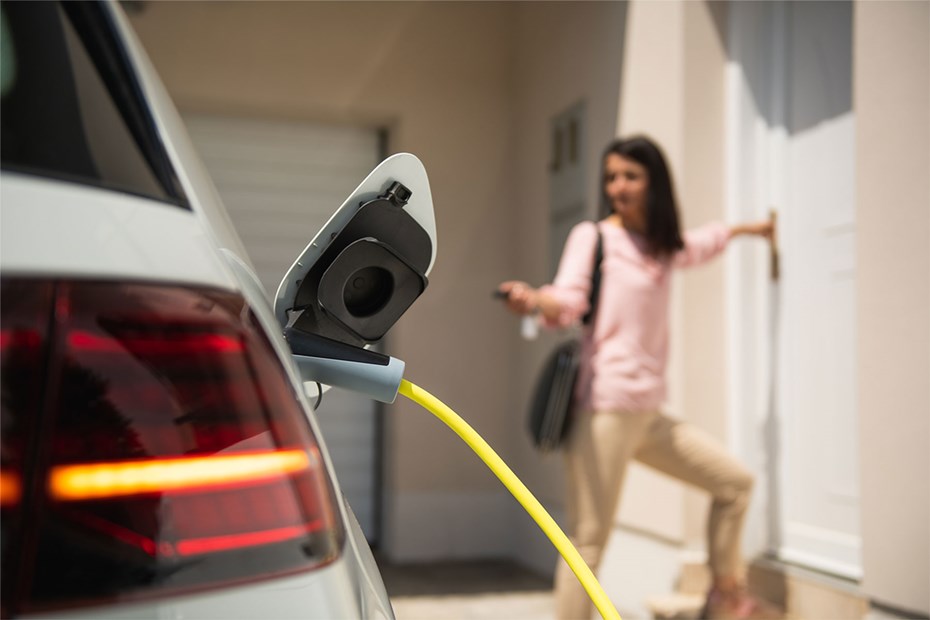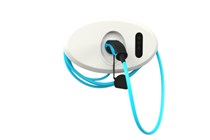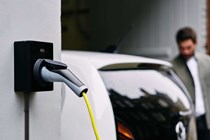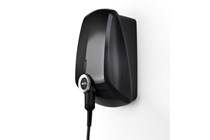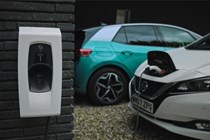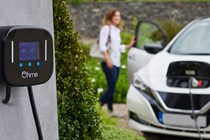Electric cars are no longer rare – they made up over 20% of all new car sales in early 2025 according to the Society of Motor Manufacturers and Traders (SMMT). With more models on the road and the government pushing for zero-emission vehicles, home charging is becoming an essential part of EV ownership.
But it’s not one-size-fits-all. Whether you’ve got a driveway or rely on street parking, this guide covers everything you need to know about charging at home in 2025.
How much does it cost to install a home electric car chargepoint?
Installing a home EV charger in 2025 typically costs between £750 and £1,500, but the final price can vary depending on a few key factors – like the type of charger you choose, where it’s being installed, and how much work needs doing to get it up and running.
That price range usually includes both the charger unit itself and standard installation (though it’s worth checking with your supplier, as this isn’t always guaranteed), which covers things like fixing the charger to a wall near your parking space, wiring it up to your electricity supply, and basic testing. Most people will go for a 7kW smart charger – this is the most common setup for UK homes and offers a good balance of charging speed and efficiency. It’s powerful enough to top up most EVs overnight and includes handy features like scheduling and app control.
For example, Ohme, quotes £949 for its untethered ePod and £999 for the tethered Home Pro, both including standard installation. That puts them right in the middle of the typical price range and shows the kind of figures you can expect when budgeting for a home charger in 2025.
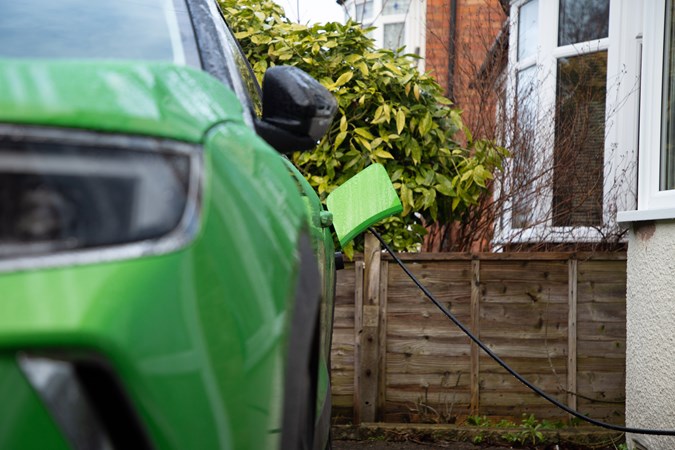
Because every home is different, it’s always best to get a personalised quote to understand exactly what your setup will cost. Factors like needing extra cabling, upgrading your fuse box, or having a parking space that’s far from your home can all push the price up. If you live in an older property or a flat, the installation might be more complex – and more expensive.
What features are important in a home EV chargepoint?
Earthing Rod
Anyone who has seen Jurassic Park knows electricity is dangerous to mammals when not managed correctly. For decades, our homes have been grounded by multiple earthing points, channelling current into a neutral place, in the event of a fault. In the early days, home electric vehicle chargepoints required a spiky length of copper, known as an earthing rod, to be buried deep into the ground, risking a pierced water pipe.
Since 2017, Pod Point has used technology to mitigate the need for an earthing rod, helping homeowners to avoid costly damage to unseen cables, while offering protection from electrocution. This literally life-saving technology detects and monitors the live voltage between the neutral and live circuits and isolates the vehicle from the charger, if a fault develops.
Several chargepoint manufacturers provide devices that don’t require earthing rods now, including myenergi and ROLEC.
Fuse Protection
EV charging points are now smart enough, through online connectivity, to detect when a vehicle is getting close to the limit where the power would trip the fuse switch and shutting down to mitigate the possibility of fusing.
Chargepoints from Indra, Easee, myenergi and Zaptec are some of the providers offering this safety feature.
Lock
Not every chargepoint is lockable, but if you’re worried about security in your area, you might wish to opt for an electric vehicle home chargepoint that can be locked. Usually, the lock is controlled by a smart phone app.
Remote control
Being able to remotely control your chargepoint offers you the utmost convenience, since you can enable various features through the connectivity in the smartphone app. Being able to schedule when your charger begins charging the car gives you the freedom to charge at cheaper periods of the day and being able to open the port, which offers you the option to let someone borrow the charger without you needing to be home.
Smart control
Smart control differs slightly from remote control. Although it offers many of the same features, Smart control can also enable third parties, such as your energy provider, to control the chargepoint. Unsurprisingly, most companies are pushing smart charging points, since they offer more versatility, if and when bi-directional charging becomes more common.
Bi-directional charging
The National Grid has worked hard to understand what kind of additional demand EVs will bring to the Grid at peak times, but bi-directional charging may alleviate some of the pain. This is where the car is used as a battery, charged during off-peak hours, or when there’s plenty of solar generated that needs ‘using’ immediately. That energy is then called upon by the Grid at peak times, perhaps being bought back at a higher price than it was sold. Thus, in some instances, EV-based households may be able to make further savings on their energy bills.
Solar integration
If you’re a homeowner that has, or intends to get, solar panels installed to offset some of the cost of your energy bills, that would be smart. In order to get the best of both worlds, you’ll want an electric vehicle charging point that will integrate seamlessly with your solar panels. This will enable the vehicle to maximise use of power generated by solar.
Andersen, Indra and myenergi home chargepoints offer this feature.
Speed
The fastest charge isn’t always the best. Most home EV chargers offer 3kW or 7kW, but if your property has a three-phase supply, you might be tempted to install a 22kW unit for quicker top-ups. However, not all electric cars can make use of that extra power – many are capped at around 7kW for AC charging, regardless of how fast the charger is. So before investing in a high-powered unit, it’s worth checking what your vehicle can actually handle.
It’s also important to consider battery health. While quicker charging sounds convenient, regularly pumping in high amounts of power can speed up long-term wear on the battery. That’s why most EVs will automatically dial things back to preserve lifespan.
Tether
When you rock up to rapid public charging points, the chances are the device is corded and you just have to open the charge port and plug in. With slower charging points, there’s often a requirement to whip out your own cable, as the device is untethered. Home chargepoints can operate in the same way. You can choose if you want the cord integrated into the device or whether you want the freedom to plug in your own independently.
Can I install my own electric vehicle charging point?
Unless you’re a qualified electrician, you shouldn’t install your own chargepoint. Ultimately, you’re dealing with electricity, which can be fatal if handled incorrectly. There’s also the added complexity in ensuring that any faults which develop with the chargepoint don’t affect the rest of the electricity supply to the house.
The top companies for manufacturing and installing EV chargepoints
The key brands in the electric car charger for home market are Andersen, Easee, EO, EVBox, Indra, Ohme, Tesla, Wallbox and Zaptec. Each brand has a different unique selling point, so deciding which point is best for you, is about working out which suits your lifestyle best.
Andersen
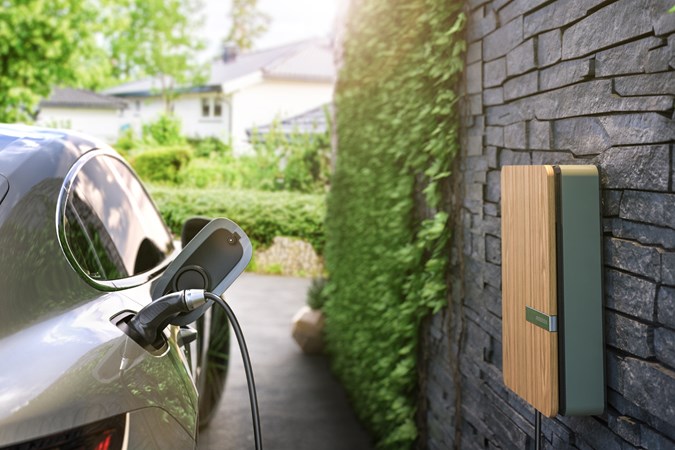
Made in the UK, Andersen has set about to create stylish chargers with intelligent connectivity to offer users the most flexibility. The sleek design integrates the tethered cable. Compatible with most car makers, including Citroen, Hyundai and Polestar, Andersen’s A2 home chargepoint comes with free over-the-air (OTA) software updates, so your experience with your chargepoint is always improving.
Easee
The Easee One is a 7.4kW home charger built with the UK market in mind. It comes with built-in 4G (via a lifetime eSIM) and Wi-Fi, so you can manage charging through the app, schedule sessions remotely, and keep tabs on your car’s status in real time.
It’s also smart enough to adjust its power output depending on the vehicle, and has in-built earthing protection – meaning there’s no need to install a separate earth rod, which can help keep installation costs down.
It’s a neat-looking unit, too. Compact and stylish, with interchangeable front covers so you can match it to your car or your house. If you have solar panels, it’s compatible with the Easee Equalizer for solar charging. Prices start at around £936 including standard installation, or roughly £499 if you’re just buying the charger and arranging fitting yourself.
EO
EO has the EO Basic, EO Mini Pro and Mini Pro 2. In June 2022, it released the EO Mini Pro 3, which is the latest version and will take over from the Mini Pro 2. Admired for its compact design and available in a choice of colours, the Mini Pro 3 has EO companion smartphone app enabling motorists to manage, monitor and schedule electric vehicle charging sessions. It innovates on the previous design by supporting both 7kW and 22kW power delivery.
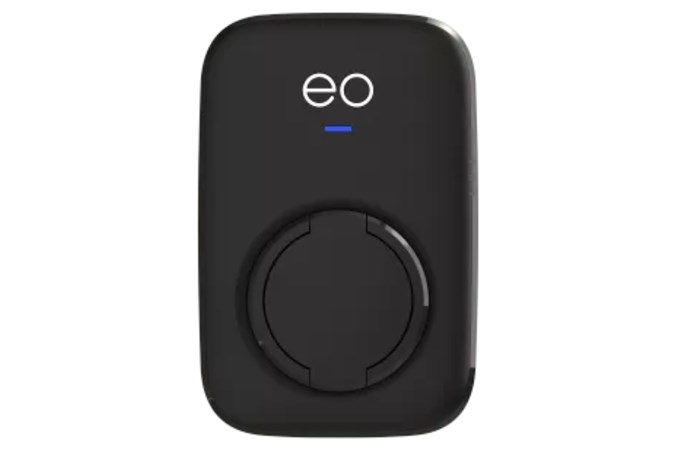
Although EO doesn’t provide earthing rods built in but advocates the use of Garo earthing technology to avoid using an earthing rod. It also offers a locking feature to prevent others using it.
EVBox
EVBox provides a lot of commercial chargepoints so it’s no surprise that it’s one of the companies offering a 22kW home charger to those households that have the capacity. Weather- and shock-proof, the EVBox isn’t the most compact design, but is neat enough, with a cable tidy for the tethered cord. The software management tool enables remote control of the point and gives charging insights, alongside automatic adjustments to manage the load from the grid.
Indra
Indra offers the Smart Pro and Smart LUX and has solutions for homeowners looking to give back to the Grid or power parts of their home using their electric car. The Smart LUX comes in at £1,175, but includes in-built integration with the cheapest and greenest tariffs, including Type of Use, Time of Use and Agile tariffs with potential annual savings of up to £830 compared with other home charger brands. It’s compact, too, with a profile of 78mm, it is the slimmest charger on the market, appealing to those who might have limited installation space or just want a more slimline unit on their house.
myenergi
myenergi’s Zappi is Britain’s best-selling EV home charger for solar integration. If that’s one of your requirements, the Zappi will definitely make the shortlist. An intuitive, smart EV charger, pricing for the Zappi starts from £779.
Ohme
Integrated with your energy tariff to take advantage of cheap charging times, the Ohme home charger is very popular with EV drivers. There’s a smart display screen on the charger so you know what’s going on at-a-glance. Of course, there’s also an app, which will control the Ohme Home, Ohme Home Pro or Ohme Go. Prices start from £449, so Ohme solutions are appealing to those on tighter budgets.

In April 2022, Ohme announced a partnership with the Motability scheme, aiming to make it easier for differently abled drivers and occupants to make the switch to electric. Then in October 2022, the brand became part of the Vauxhall and Octopus Energy partnership.
Pod Point
One of the longest established electric vehicle charging providers in the UK, Pod Point offers both residential and commercial chargepoints. Its home charging solution starts from £849 fully installed. Offering the most compatibility with the widest range of car brands on this list, there’s a choice of 3.6kW, 7kW or 22kW power devices. There’s remote and smart control, enabling montoring, scheduling and load balancing to manage your home charging without hassle.
ROLEC
ROLEC’s Wallpod EV:Home Smart is one of the more affordable options on the market, starting from around £913 including standard installation. It’s a 7.4kW charger, available in both tethered and socketed versions, and includes built-in earthing, so there’s no need for an extra earth rod – a bonus that can help keep installation simple.
Made in the UK, it connects to the ev.energy app, letting you schedule charging and keep an eye on your energy use straight from your phone. ROLEC also offers portable charging units for small businesses and even caravan hook-up solutions, so it’s a versatile brand for different needs.
Tesla
There’s no denying Tesla’s approach has been the most holistic, incorporating a Supercharging network into the sales of its futuristic cars. The future has now arrived and presently, you can get a Tesla Gen 3 Wall Connector from £469. Featuring OTA updates and a tethered cable so you don’t need to mess on getting the vehicle cable out, the charging speeds vary, depending on the vehicle.
Wallbox
Wallbox chargers aren’t the cheapest, with prices starting from around £1,200 including installation, but they pack in plenty of features. Options include bi-directional charging, smart display screens and compact, stylish designs. Models like the Pulsar Max and Quasar 2 are compatible with most electric cars and support smart charging via the Wallbox app.
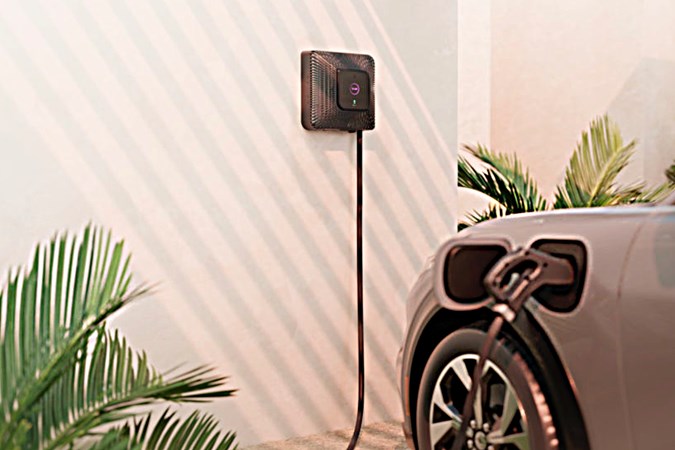
Zaptec
Zaptec’s stylish Scandi design couples with Nordic technology to create a compact, visually-pleasing chargepoint, capable of 22kW power. The Zaptec Go is the size of a tablet and available in a range of colours to make it blend or stand out, as desired. Some 80% smaller and lighter than other chargers on the market, Zaptec is keen to emphasise that, like its rivals, it can be remotely controlled so charging can be done when tariff prices are much lower and updates remotely to stay relevant to the market.
Can you get your charging point installed for free?
In short, no. Once upon a time, car makers would have assisted with the cost of the device and installation. However, as electric cars have become more popular, such incentives have become too costly.
The Electric Vehicles Homecharge Scheme (EVHS), also known as the OZEV (previously OLEV) grant, which sees the government put up to 75%, capped at £350, towards the cost of getting an electric vehicle charging point installed, came to an end for homeowners in March 2022. Anyone not living in a flat or rented properties can continue to benefit from the scheme and Scottish residents can still seek assistance from the Charge Scotland programme.
In order to meet the criteria, the charging point must be fitted, signed off by the installation company and submitted to the DVLA before you can claim the money back. And all of that needs to be done before the deadline.
Why is it so expensive to install an EV home charger?
The cost of EV charging point installation isn’t cheap. The initial cost means switching to an electric vehicle requires a lot of expense upfront. What’s more, some providers charge a nominal monthly subscription (£5 or so) to maintain the software interface that enables you to schedule charges, integrate solar panel production, etc.
Because the technology is so nascent, it’s pretty pricey. What’s more, these fancy devices tend to have some levels of connectivity with Wifi or 4G networks. The cost of EV chargers is influenced by factors such as global semiconductor shortages and the need for qualified electricians for installation. However, as the market matures and technology becomes more widespread, prices are expected to decrease over time.
Just so you know, we may receive a commission or other compensation from the links on this website - read why you should trust us.


